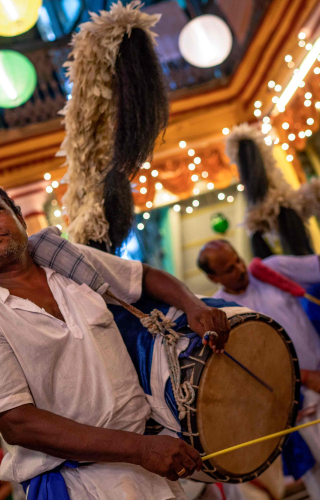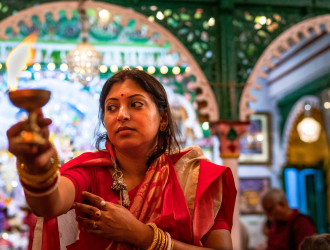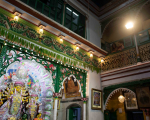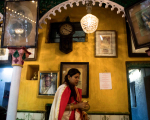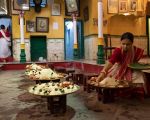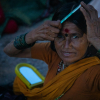Durga Puja (worship of Durga) is a major religious festival for Hindus in West Bengal, Bihar, Tripura, Odisha, Assam, Mithila and other parts of India and Bangladesh. In the rest of India, it coincides with Navaratri and Dussehra, and with Dashain in Nepal, all of which signify the victory of good over evil. Durga Puja is celebrated in autumn (Sharad), in the months of September or October. In Kolkata, Durga Puja was first organised in 1610 CE by the Sabarna Roy Chowdhury family at their ancestral home at Barisha. They were zamindars (hereditary landowners with the right to collect tax) during the Mughal period and held zamindari rights of Sutanuti, Gobindapur and Kolkata villages, which were acquired by the British East India Company (BEIC).
The BEIC merged the three villages to establish Kolkata. As the capital of the British Empire, Kolkata emerged as a major trading port, and enterprising Bengalis migrated to the city and made their fortune in business, trade, banking, and working for the BEIC as administrators, civil servants and zamindars. These nouveau riche Bengalis settled in Sutanuti, in what is today’s North Kolkata, where they built palatial mansions along Chitpur Road, the only arterial road of the city 300 years ago. Thus, these Bengali families were the symbols of aristocracy and were considered the foundation of Kolkata’s haute society and high culture. In the eighteenth and nineteenth centuries, they came to be known as bonedibari in colloquial Bengali; bonedi, derived from buniyadi, meaning foundation, and bari meaning house/family.
After centuries of Islamic rule, protection under the British guns of Fort William allowed elite Bengali Hindus to express their religiosity more publicly, and they organised grand festivals, spending astronomical sums of money. Durga Puja celebrations became increasingly popular in bonedi baris of Kolkata, and, for this purpose, a thakur dalan is a common feature in all these mansions. Several weeks before the festival, bonedi baris employed potters (kumars) to create clay idols of the gods and goddesses, working as a team in the thakur dalan.
Durga Puja is a ten-day festival. The purpose of the festival is to observe four important events. Firstly, it celebrates the annual visit of goddess Parvati to her natal home from her abode in Mount Kailash, where she resides with her consort, Lord Shiva. She descends from Kailash with an entourage consisting of her daughters, Lakshmi and Saraswati, and her sons, Ganesha and Kartik. In some cases, Lord Shiva also accompanies them.
Secondly, Durga Puja celebrates Devi Durga’s victory over Mahishasura, a mighty asura (malevolent demigods), who had gained a boon from Lord Brahma that no man could kill him. Immunised by this boon, he attacked the gods, defeating them in battle. Exasperated by his victories over them, all the gods converged their energies to create Durga, a female goddess. Armed with various divine weapons, Durga slays Mahishaura in combat, which earns her the title Mahishasurmardini (slayer of Mahishasura). The last and tenth day is thus known as Vijaya Dashami, commemorating the final victory of good over evil.
Thirdly, Durga Puja is linked to the agricultural cycle and serves as a thanksgiving for a good harvest. Conventionally, Durga worship takes place in the Spring season (Basanta), which is also a harvest period and coincides with the Chaitra Navratri, held in April, during the commencement of the Bengali new year. The worship of Durga in the month of Ashwin, which is followed in Bengal, is known as Akaal Bodhan (uncustomary time of worship), and coincides with the post-monsoon harvest. On the seventh day (Maha Saptami), a banana stalk (Kola Bou) is washed in the River Ganga and worshiped together with a combination of eight other crops and sacred plants, the navapatrika. The worship of navapatrika is to ensure an abundance of harvest and it has roots in nature worship, also practised by various agricultural communities.
Fourthly, because Devi Durga is a manifestation of Parvati, the counterpart of Lord Shiva (The Supreme Lord), she is an expression of Adi Shakti (Primordial energy). This energy is the Divine Mother, the source of all creation in the universe and the energy that governs it. All goddesses are manifestations of Adi Shakti, either in loving, motherly form like Parvati, or in her destructive, warrior form like Kali or Durga. In Bengal, major Hindu festivals are linked to the worship of various manifestations of the Divine Mother, in the form of Durga, Lakshmi, Kali, Saraswati or Jagaddhatri. During Durga Puja, Adi Shakti is also worshipped in the form of a prepubescent young girl who is assigned temporary sacredness as the earthly manifestation of Devi Durga. This special ritual—Kumari Puja—is practised by several bonedi baris in Kolkata.
A maiden is the unrealised potential of Adi Shakti. No distinction of race, religion or caste is made in choosing a maiden for Kumari Puja. Theoretically, any maiden can qualify, however, in practice, usually, a Brahmin girl is chosen. According to Hindu scriptures, Kumari Puja commemorates the killing of Kolasur by the Goddess Kali. According to legend, Kolasur had occupied the heavens and the earth. The helpless deities approached Mahakali for help. Responding to their appeal, she was born again as a maiden (Kumari) and killed Kolasur.
Kumari Puja has a strong socio-religious connection to Bengal. Sri Ramakrishna Paramahamsa, a leading figure of the Bengal Renaissance, worshipped his wife and spiritual consort, Sri Sarada Devi, as the manifestation of the Divine Mother. Later, after the establishment of the Ramakrishna Mission monastic order at Belur Math, Swami Vivekananda continued the custom of Kumari Puja during Durga Puja. He was a firm believer that ‘to look upon God as Mother is the purest and the highest form of Sadhana.’ The philosophical basis of Kumari Puja is to unleash the potential of the energy that regulates all creation, stability and destruction.
Though we venerate the Divine Mother and Adi Shakti during festivals like Durga Puja, India remains largely a misogynistic patriarchal society, and excessive religious orthodoxy continues to victimise women. Even after seven decades of Independence, scores of women continue to suffer violence, discrimination and injustice in the name of family, tradition, culture and honour. Female foeticide is still a raging problem in many Indian states. The girl child needs social empowerment, education, respect, safety and economic freedom in a true sense. As a society, we must ensure that a girl child is treated equally and should be nurtured in such a way that she can choose her own destiny by breaking all glass ceilings imposed by society. Until that happens, merely treating a girl child like a goddess for a few days in the year will not bring any true change to her role and position in Indian society.
This photo-essay has been created as part of the Sahapedia Frames Photography Grant, supported by CSR funding from IndusInd Bank.
